MongoDB Connector for Camunda 8- Part III
In the previous segment, we honed our data retrieval skills, allowing us to uncover valuable insights from our collections in MongoDB database. In this concluding part, let’s discuss the remaining operations like updating documents, deleting documents, dropping collections and even database.
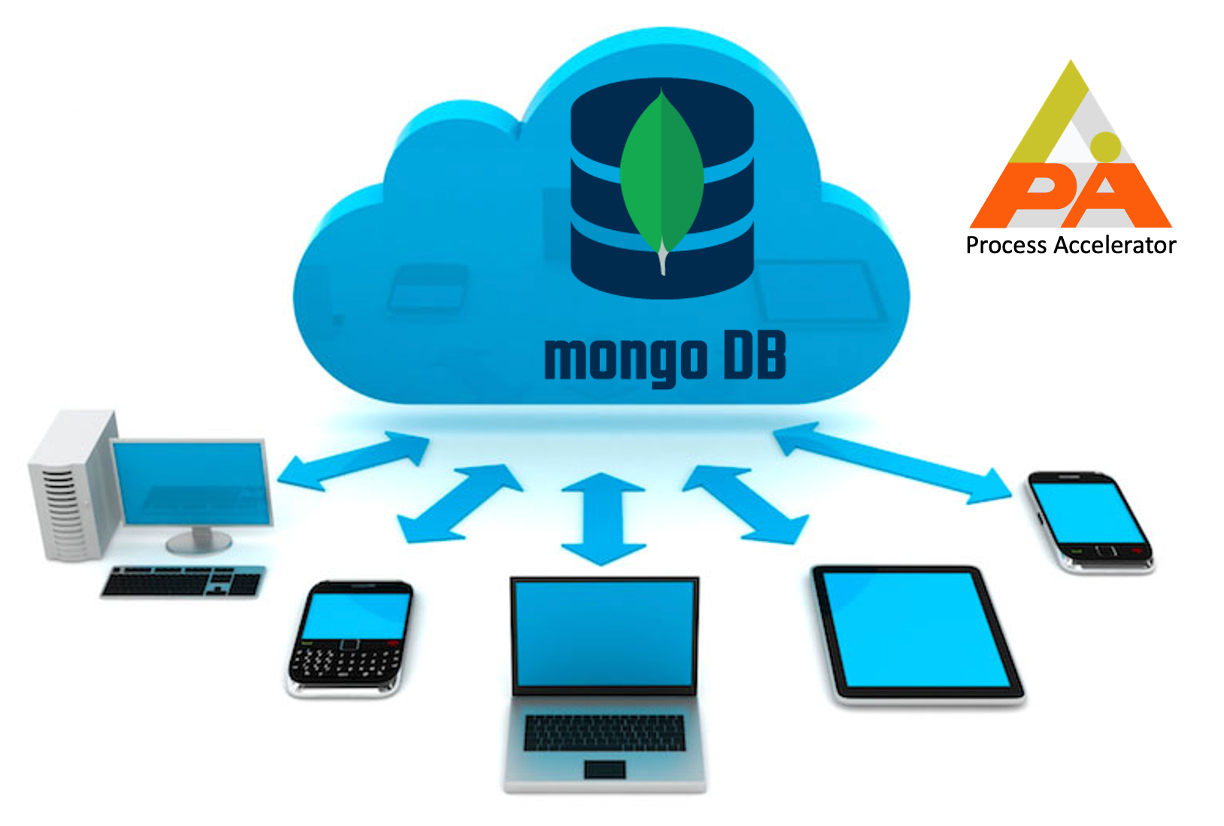
The MongoDB Connector - Part-III is about Update and Delete operations.
Welcome to the concluding part of our MongoDB blog series! In the previous segment, we honed our data retrieval skills, allowing us to uncover valuable insights from our collections in MongoDB database. In this concluding part, let's discuss the remaining operations like updating documents, deleting documents, dropping collections and even database.
Update Documents:
In the ticket booking scenario, many a times, cases may arise that the user needs to update the journey details, with reschedulable tickets support in the process. Let’s model the process.
- First, I am creating a form to facilitate the process.
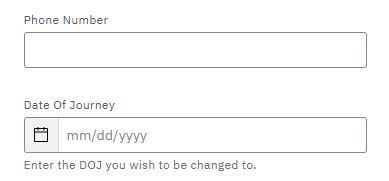
- And here is my BPMN, where I will be updating the document based on the matching Phone Number.

- Okay, now, let’s start the instance, and fill the form in the Tasklist.

- And, this is the response which we have got as a part of the connector execution.

- Upon cross-verifying the record with the matching phone number in the MongoDB Compass, I am able to see the changes persisted in the DB.
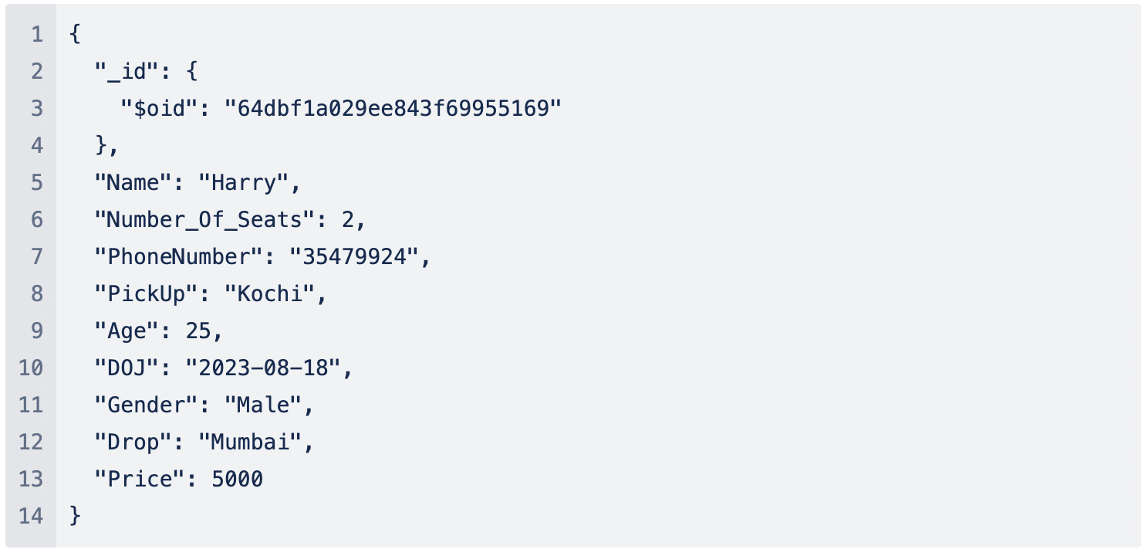
- Update Operation also supports Limit operation, where only the number of documents that is given as limit is updated, when there are more number of matching documents available, or no filters are available. If filters are null, and limit is null, the operation is just ignored and all the documents present in the database is updated.
Delete Documents:
- In our case, we need not store very old trip data or need it in the long run. So, let’s say after some 6 months, we are planning to delete the data. Let’s walk through how we can do this with our MongoDB Custom Connector. Similar to the Retrieve and Update, here too we have filters and limit.
- When we give a specific condition in the filters, then only the documents that match that filter is deleted.

- For example, in this case, I have given the filter to delete when ten PickUp point is Kochi. Seems, only one document is matched and we get the response as below.

- Next, we will try giving without any filter or limit, that is, with their default value, null. If the value of these are null, then that respective operation is ignored in the context. Now, let’s deploy the process and start an instance of it.
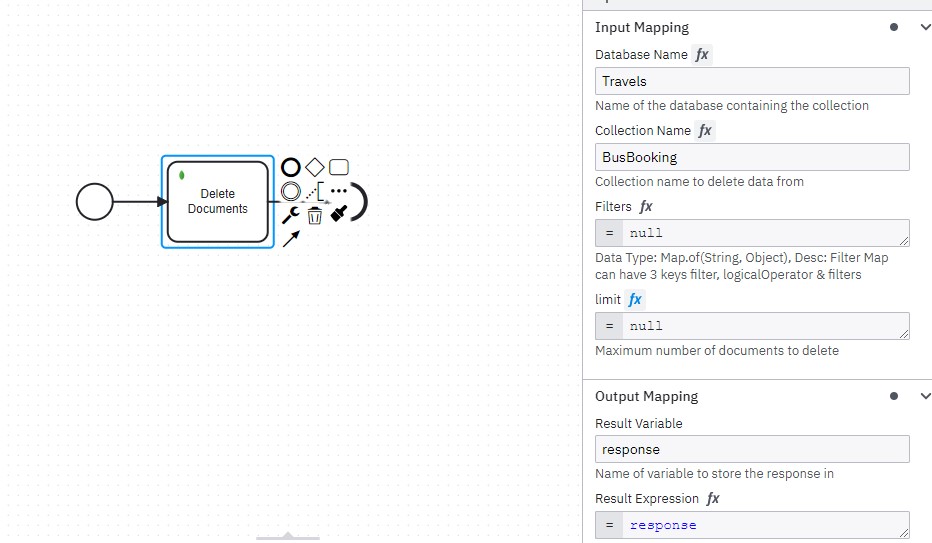
- We are able to see the response in the Operate as below. All the 7 records that were present in the database are deleted.
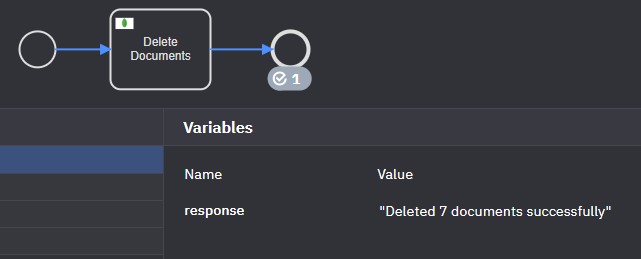
Drop Collection:
- Now that, we have deleted all the bookings (documents) from the collection, and using another collection to store the present bookings, we dont need this specific collection right now to be existent in the database. So, let's delete this collection.
- Upon configuring the activity as MongoDB Connector, and selecting the operation as Drop Collection, we will be required to input the Database Name and a Collection Name.
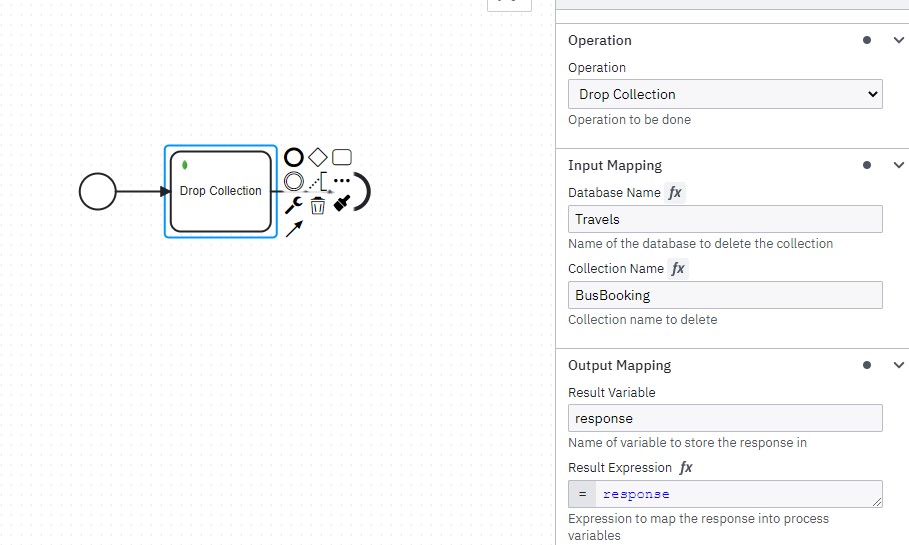
- Once we deploy the diagram and start an instance of the process, we are able to see the response from the connector is Operate as below -

- Also, if there is only one collection present in the database, and we are deleting that collection, then the database gets deleted too.
Drop Database:
- Let’s try dropping the entire database from MongoDB. Upon configuring the activity as a MongoDB Connector, and selecting the operation as “Drop Database”, we will be required to give the Database Name to drop.
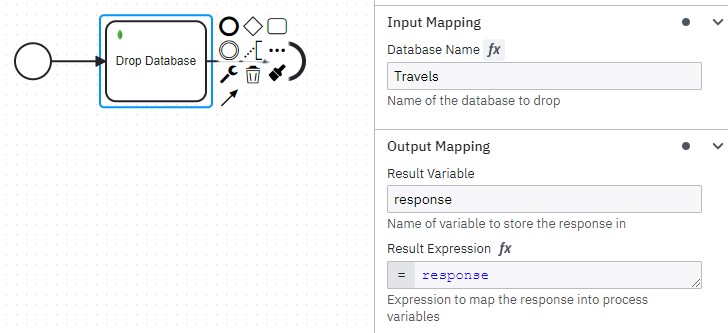
- Here, I have given the Database Name and have started the instance. We are able to see in Operate, as a response the following output.
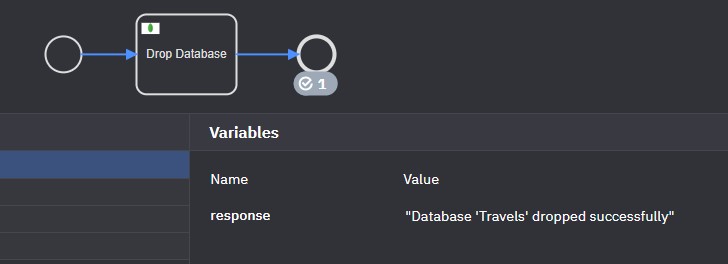
In this series, we've travelled through the fundamental operations that our MongoDB connector offers. From creating collections and inserting data to retrieving and manipulating it, we now have a solid grasp of our connector’s capabilities.
Contact :
|
Sources |
Link |
|---|---|
|
E - Mail |
|
|
Youtube Video |
MongoDB Connector for Camunda 8- Part III
More to explore

MongoDB Connector for Camunda 8- Part III
In the previous segment, we honed our data retrieval skills, allowing us to uncover valuable insights from our collections in MongoDB database. In this concluding part, let’s discuss the remaining operations like updating documents, deleting documents,
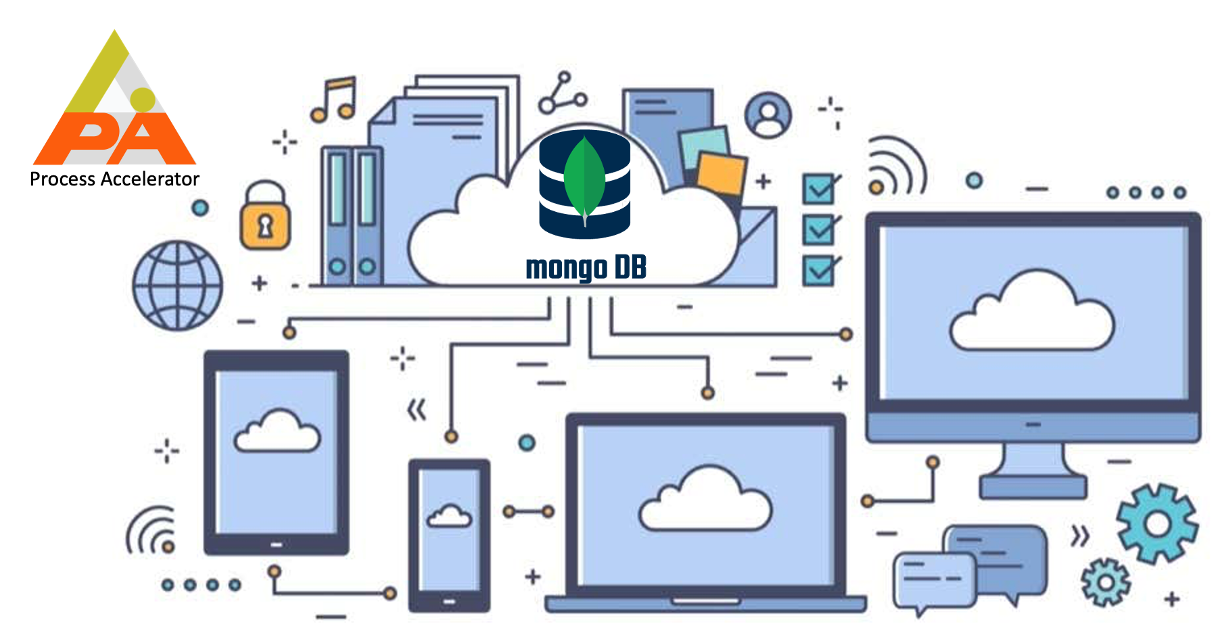
MongoDB Connector for Camunda 8- Part II
In the previous part, we laid the groundwork by creating collections and inserting documents into them. Now, it’s time to extract valuable insights from your data using MongoDB’s robust querying
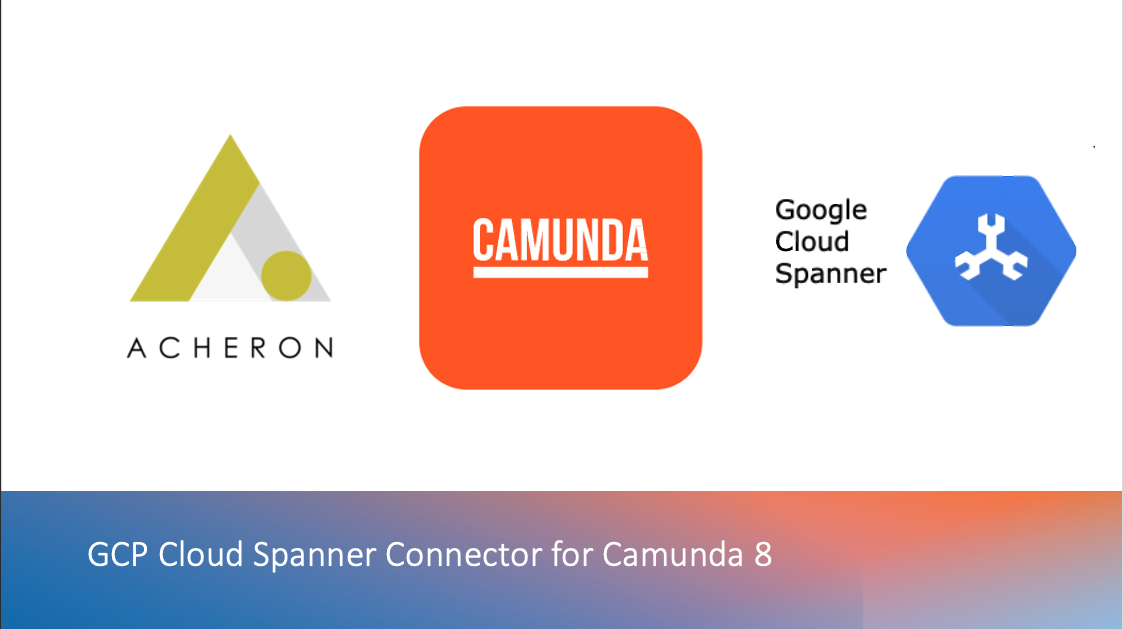
GCP Cloud Spanner Connector for Camunda 8
Integrating Camunda with Google Cloud Spanner offers a powerful combination of workflow automation and a globally distributed, horizontally scalable database. Google Cloud Spanner provides strong consistency and high availability, making it suitable for
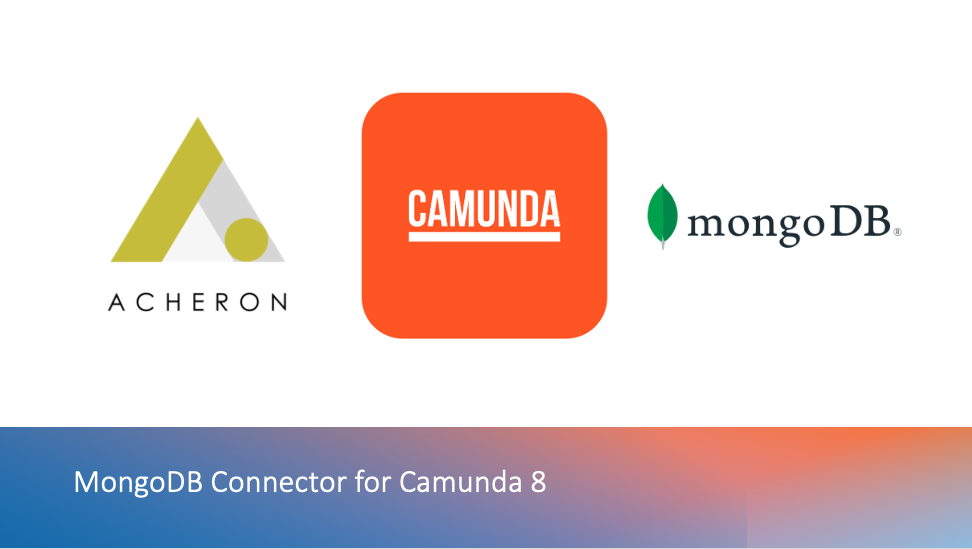
MongoDB Connector for Camunda 8- Part I
Integrating Camunda, a popular open-source workflow automation and business process management platform, with MongoDB, a NoSQL database, can offer powerful capabilities for managing and executing business processes while efficiently storing and retrieving

Google Cloud Storage Connector
Whether you’re saving photos, important documents, or sharing files on GCS – this GCS Connector makes managing your digital content more convenient for intended users. It’s like having a reliable assistant for your data tasks, making things

Acheron Newsletter Q1 FY23
A growth strategy is an organisation’s plan for achieving current and future objectives to realize its goals of

Software Testing – Third Eye View
Everyone knows what Software Testing is, but here are some challenges and how to overcome those challenges. The primary focus of a software tester would be to stay very close to theoretical stuff and still reach out to match the reality by understanding the

Our Solution to your Market Penetration Strategy.
Who doesn’t want their business to grow? In fact everyone like to see growth in business. This seems pretty true – Considering effective and successful growth means your business is experiencing a boost in revenue, brand awareness, brand

Acheron’s CHILI Publish connector for OpenText Media Management
The technological advances that have occurred in the Media Industry (print & digital) in the past decade has presented content creators with a wealth of new revenue streams. Increasingly, Media based industries around the globe are implementing

Acheron MLR Digital Publishing App – An Overview
Medical Legal Review has always been one of the most challenging and complex aspects of the marketing production process for Life Sciences companies. Life science company’s field force (including but not limited to AEs, MSLs, Field Marketing etc..) has not

Acheron Medical Legal Review (MLR) – A Product Overview
Medical Legal Review (MLR) has always been one of the most challenging and complex aspects of the marketing production process for Life Sciences companies. Organizations need a fresh approach to MLR that enables a timely and efficient marketing workflow and

Acheron Media Project Management (MPM) – A Product Overview
Acheron MPM is a comprehensive solution to empower the marketing teams and project manager to manage all their creative workflow in one place, from inception to consumption. It automates your digital media life cycle and delivers a holistic approach to

4 and a half reasons Standard Project Management applications fail media projects
I know that triggers a curiosity in your mind – what are these four and a half reasons? Well, thank you for taking your time to read through these findings that I could build over the past one and a half years of my exposure to this domain. You

Acheron Media Project Management (MPM) – An Executive Brief
One of the few challenges marketing project managers face in their routine is to keep track of tasks and their current status. This could be due to the complex workflows involved in their projects and having to work with a multitude of tasks that are

